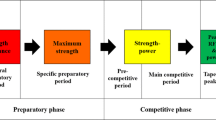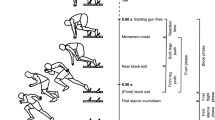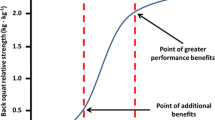Abstract
Background
Current recommendations on resistance training (RT) frequency for gains in muscular strength are based on extrapolations from limited evidence on the topic, and thus their practical applicability remains questionable.
Objective
To elucidate this issue, we conducted a systematic review and meta-analysis of the studies that compared muscular strength outcomes with different RT frequencies.
Methods
To carry out this review, English-language literature searches of the PubMed/MEDLINE, Scopus, and SPORTDiscus databases were conducted. The meta-analysis was performed using a random-effects model. The meta-analysis models were generated with RT frequencies classified as a categorical variable as either 1, 2, 3, or 4+ times/week, or, if there were insufficient data in subgroup analyses, the training frequencies were categorized as 1, 2, or 3 times/week. Subgroup analyses were performed for potential moderators, including (1) training volume; (2) exercise selection for the 1 repetition maximum (RM) test (for both multi-joint and single-joint exercises); (3) upper and lower body strength gains; (4) training to muscular failure (for studies involving and not involving training to muscular failure); (5) age (for both middle-aged/older adults and young adults); and (6) sex (for men and for women). The methodological quality of studies was appraised using the modified Downs and Black checklist.
Results
A total of 22 studies were found to meet the inclusion criteria. The average score on the Downs and Black checklist was 18 (range 13–22 points). Four studies were classified as being of good methodological quality, while the rest were classified as being of moderate methodological quality. Results of the meta-analysis showed a significant effect (p = 0.003) of RT frequency on muscular strength gains. Effect sizes increased in magnitude from 0.74, 0.82, 0.93, and 1.08 for training 1, 2, 3, and 4+ times per week, respectively. A subgroup analysis of volume-equated studies showed no significant effect (p = 0.421) of RT frequency on muscular strength gains. The subgroup analysis for exercise selection for the 1RM test suggested a significant effect of RT frequency on multi-joint (p < 0.001), but not single-joint, 1RM test results (p = 0.324). The subgroup analysis for upper and lower body showed a significant effect of frequency (p = 0.004) for upper body, but not lower body, strength gains (p = 0.070). In the subgroup analysis for studies in which the training was and was not carried out to muscular failure, no significant effect of RT frequency was found. The subgroup analysis for the age groups suggested a significant effect of training frequency among young adults (p = 0.024), but not among middle-aged and older adults (p = 0.093). Finally, the subgroup analysis for sex indicated a significant effect of RT frequency on strength gains in women (p = 0.030), but not men (p = 0.190).
Conclusions
The results of the present systematic review and meta-analysis suggest a significant effect of RT frequency as higher training frequencies are translated into greater muscular strength gains. However, these effects seem to be primarily driven by training volume because when the volume is equated, there was no significant effect of RT frequency on muscular strength gains. Thus, from a practical standpoint, greater training frequencies can be used for additional RT volume, which is then likely to result in greater muscular strength gains. However, it remains unclear whether RT frequency on its own has significant effects on strength gain. It seems that higher RT frequencies result in greater gains in muscular strength on multi-joint exercises in the upper body and in women, and, finally, in contrast to older adults, young individuals seem to respond more positively to greater RT frequencies. More evidence among resistance-trained individuals is needed as most of the current studies were performed in untrained participants.

Similar content being viewed by others
References
Carroll TJ, Riek S, Carson RG. Neural adaptations to resistance training: implications for movement control. Sports Med. 2001;31(12):829–40.
Steib S, Schoene D, Pfeifer K. Dose-response relationship of resistance training in older adults: a meta-analysis. Med Sci Sports Exerc. 2010;42(5):902–14.
Suchomel TJ, Nimphius S, Stone MH. The importance of muscular strength in athletic performance. Sports Med. 2016;46(10):1419–49.
American College of Sports Medicine. American College of Sports Medicine position stand. Progression models in resistance training for healthy adults. Med Sci Sports Exerc. 2009;41(3):687–708.
Baechle TR, Earle RW, Wathen D. Resistance training. In: Earle RW, Baechle TR, editors. Essentials of strength training and conditioning. 3rd ed. Champaign: Human Kinetics; 2008. p. 381–412.
Ralston GW, Kilgore L, Wyatt FB, et al. The effect of weekly set volume on strength gain: a meta-analysis. Sports Med. 2017;47(12):2585–601.
Carpinelli RN, Otto RM. Strength training. Single versus multiple sets. Sports Med. 1998;26(2):73–84.
Schoenfeld BJ, Grgic J, Ogborn D, et al. Strength and hypertrophy adaptations between low- versus high-load resistance training: a systematic review and meta-analysis. J Strength Cond Res. 2017;31(12):3508–23.
Schoenfeld BJ, Wilson JM, Lowery RP, et al. Muscular adaptations in low- versus high-load resistance training: a meta-analysis. Eur J Sport Sci. 2016;16(1):1–10.
Candow DG, Burke DG. Effect of short-term equal-volume resistance training with different workout frequency on muscle mass and strength in untrained men and women. J Strength Cond Res. 2007;21(1):204–7.
McLester JR, Bishop P, Guilliams ME. Comparison of 1 day and 3 days per week of equal-volume resistance training in experienced subjects. J Strength Cond Res. 2000;14(3):273–81.
Schoenfeld BJ, Ratamess NA, Peterson MD, et al. Influence of resistance training frequency on muscular adaptations in well-trained men. J Strength Cond Res. 2015;29(7):1821–9.
Thomas MH, Burns SP. Increasing lean mass and strength: a comparison of high frequency strength training to lower frequency strength training. Int J Exerc Sci. 2016;9(2):159–67.
Benton MJ, Kasper MJ, Raab SA, et al. Short-term effects of resistance training frequency on body composition and strength in middle-aged women. J Strength Cond Res. 2011;25(11):3142–9.
Fernández-Lezaun E, Schumann M, Mäkinen T, et al. Effects of resistance training frequency on cardiorespiratory fitness in older men and women during intervention and follow-up. Exp Gerontol. 2017;95:44–53.
Gentil P, Fischer B, Martorelli AS, et al. Effects of equal-volume resistance training performed one or two times a week in upper body muscle size and strength of untrained young men. J Sports Med Phys Fitness. 2015;55(3):144–9.
Lera Orsatti F, Nahas EA, Maestá N, et al. Effects of resistance training frequency on body composition and metabolics and inflammatory markers in overweight postmenopausal women. J Sports Med Phys Fitness. 2014;54(3):317–25.
Murlasits Z, Reed J, Wells K. Effect of resistance training frequency on physiological adaptations in older adults. J Exerc Sci Fit. 2012;10(1):28–32.
Padilha CS, Ribeiro AS, Fleck SJ, et al. Effect of resistance training with different frequencies and detraining on muscular strength and oxidative stress biomarkers in older women. Age. 2015;37(5):104.
Silva RG, Silva DRP, Pina FLC. Effect of two different weekly resistance training frequencies on muscle strength and blood pressure in normotensive older women. Rev Bras Cineantropom Hum. 2017;19(1):118–27.
Moher D, Liberati A, Tetzlaff J, et al. Preferred reporting items for systematic reviews and meta-analyses: the PRISMA statement. Ann Intern Med. 2009;151(4):264–9.
Fleck SJ, Kraemer WJ. Designing resistance training programs. In: Fleck SJ, Kraemer WJ, editors. Physiological adaptations to resistance training. 4th ed. Champaign: Human Kinetics; 2014. p. 52.
Downs SH, Black N. The feasibility of creating a checklist for the assessment of the methodological quality both of randomised and non-randomised studies of health care interventions. J Epidemiol Commun Health. 1998;52(6):377–84.
Davies TB, Kuang K, Orr R, et al. Effect of movement velocity during resistance training on dynamic muscular strength: a systematic review and meta-analysis. Sports Med. 2017;47(8):1603–17.
Grgic J, Schoenfeld BJ, Skrepnik M, et al. Effects of rest interval duration in resistance training on measures of muscular strength: a systematic review. Sports Med. 2018;48(1):137–51.
Tipton E. Small sample adjustments for robust variance estimation with meta-regression. Psychol Methods. 2015;20(3):375–93.
Morris B. Estimating effect sizes from pretest-posttest-control group designs. Organ Res Methods. 2008;11(2):364–86.
Borenstein M, Hedges LV, Higgins JPT. Effect sizes based on means. In: Borenstein M, Hedges LV, Higgins JPT, Rothstein HR, editors. Introduction to meta-analysis. New York: Wiley; 2009. p. 21–32.
Hedges LV, Tipton E, Johnson MC. Robust variance estimation in meta-regression with dependent effect size estimates. Res Synth Methods. 2010;1(1):39–65.
Thompson SG, Sharp SJ. Explaining heterogeneity in meta-analysis: a comparison of methods. Stat Med. 1999;18(20):2693–708.
Gentil P, Del Vecchio FB, Paoli A, et al. Isokinetic dynamometry and 1RM tests produce conflicting results for assessing alterations in muscle strength. J Hum Kinet. 2017;56:19–27.
Ferrari R, Kruel LF, Cadore EL, et al. Efficiency of twice weekly concurrent training in trained elderly men. Exp Gerontol. 2013;48(11):1236–42.
Fisher G, McCarthy JP, Zuckerman PA, et al. Frequency of combined resistance and aerobic training in older women. J Strength Cond Res. 2013;27(7):1868–76.
Arazi H, Asadi A. Effects of 8 weeks equal-volume resistance training with different workout frequency on maximal strength, endurance and body composition. Int J Sports Sci Eng. 2011;5(2):11–8.
Hunter GR. Changes in body composition, body build and performance associated with different weight training frequencies in males and females. Natl Strength Cond Assoc J. 1985;7(1):26–8.
Brazell-Roberts JV, Thomas LE. Effects of weight training frequency on the self-concept of college females. J Appl Sports Sci Res. 1989;3(2):40–3.
Carroll TJ, Abernethy PJ, Logan PA, et al. Resistance training frequency: strength and myosin heavy chain responses to two and three bouts per week. Eur J Appl Physiol Occup Physiol. 1998;78(3):270–5.
DiFrancisco-Donoghue J, Werner W, Douris PC. Comparison of once-weekly and twice-weekly strength training in older adults. Br J Sports Med. 2007;41(1):19–22.
Faigenbaum AD, Milliken LA, Loud RL, et al. Comparison of 1 and 2 days per week of strength training in children. Res Q Exerc Sport. 2002;73(4):416–24.
Gregory LW. Some observations on strength training and assessment. J Sports Med Phys Fit. 1981;21(2):130–7.
McKenzie Gillam G. Effects of frequency of weight training on muscle strength enhancement. J Sports Med Phys Fit. 1981;21(4):432–6.
Taaffe DR, Duret C, Wheeler S, et al. Once-weekly resistance exercise improves muscle strength and neuromuscular performance in older adults. J Am Geriatr Soc. 1999;47(10):1208–14.
Ribeiro AS, Schoenfeld BJ, Silva DR, et al. Effect of two- versus three-way split resistance training routines on body composition and muscular strength in bodybuilders: a pilot study. Int J Sport Nutr Exerc Metab. 2015;25(6):559–65.
Ploutz-Snyder LL, Giamis EL. Orientation and familiarization to 1RM strength testing in old and young women. J Strength Cond Res. 2001;15(4):519–23.
Mattocks KT, Buckner SL, Jessee MB, et al. Practicing the test produces strength equivalent to higher volume training. Med Sci Sports Exerc. 2017;49(9):1945–54.
Dankel SJ, Buckner SL, Jessee MB, et al. Correlations do not show cause and effect: not even for changes in muscle size and strength. Sports Med. 2018;48(1):1–6.
Dankel SJ, Counts BR, Barnett BE, et al. Muscle adaptations following 21 consecutive days of strength test familiarization compared with traditional training. Muscle Nerve. 2017;56(2):307–14.
Ferreira DV, Ferreira-Júnior JB, Soares SR, et al. Chest press exercises with different stability requirements result in similar muscle damage recovery in resistance-trained men. J Strength Cond Res. 2017;31(1):71–9.
Soares S, Ferreira-Junior JB, Pereira MC, et al. Dissociated time course of muscle damage recovery between single- and multi-joint exercises in highly resistance-trained men. J Strength Cond Res. 2015;29(9):2594–9.
Wernbom M, Augustsson J, Thomeé R. The influence of frequency, intensity, volume and mode of strength training on whole muscle cross-sectional area in humans. Sports Med. 2007;37(3):225–64.
Housh DJ, Housh TJ, Johnson GO, et al. Hypertrophic response to unilateral concentric isokinetic resistance training. J Appl Physiol. 1992;73(1):65–70.
Gentil P, Ferreira-Junior JB, Bemben MG, et al. The effects of resistance training on lower and upper body strength gains in young women. Int J Kinesiol Sports Sci. 2015;3(3):18–23.
Gentil P. Comment on: “Determining strength: a case for multiple methods of measurement”. Sports Med. 2017;47(9):1901–2.
Davies T, Orr R, Halaki M, et al. Effect of training leading to repetition failure on muscular strength: a systematic review and meta-analysis. Sports Med. 2016;46(4):487–502.
Morán-Navarro R, Pérez CE, Mora-Rodríguez R, et al. Time course of recovery following resistance training leading or not to failure. Eur J Appl Physiol. 2017;117(12):2387–99.
Ferreira DV, Gentil P, Soares SRS, et al. Recovery of pectoralis major and triceps brachii after bench press exercise. Muscle Nerve. 2017;56(5):963–7.
Hunter GR, McCarthy JP, Bamman MM. Effects of resistance training on older adults. Sports Med. 2004;34(5):329–48.
Borde R, Hortobágyi T, Granacher U. Dose–response relationships of resistance training in healthy old adults: a systematic review and meta-analysis. Sports Med. 2015;45(12):1693–720.
Loustalot F, Carlson SA, Kruger J, et al. Muscle-strengthening activities and participation among adults in the United States. Res Q Exerc Sport. 2013;84(1):30–8.
Barbalho MSM, Gentil P, Izquierdo M, et al. There are no no-responders to low or high resistance training volumes among older women. Exp Gerontol. 2017;99:18–26.
Izquierdo M, Ibañez J, Hakkinen K, et al. Once weekly combined resistance and cardiovascular training in healthy older men. Med Sci Sports Exerc. 2004;36(3):435–43.
Roth SM, Martel GF, Ivey FM, et al. High-volume, heavy-resistance strength training and muscle damage in young and older women. J Appl Physiol. 2000;88(3):1112–8.
Flores DF, Gentil P, Brown LE, et al. Dissociated time course of recovery between genders after resistance exercise. J Strength Cond Res. 2011;25(11):3039–44.
Raastad T, Kirketeig A, Wolf D, et al. Powerlifters improved strength and muscular adaptations to a greater extent when equal total training volume was divided into 6 compared to 3 training sessions per week. In: 17th Annual conference of the European College of Sport Science, Brugge.
Mazzetti SA, Kraemer WJ, Volek JS, et al. The influence of direct supervision of resistance training on strength performance. Med Sci Sports Exerc. 2000;32(6):1175–84.
Gentil P, Bottaro M. Influence of supervision ratio on muscle adaptations to resistance training in nontrained subjects. J Strength Cond Res. 2010;24(3):639–43.
Lacroix A, Hortobágyi T, Beurskens R, et al. Effects of supervised vs. unsupervised training programs on balance and muscle strength in older adults: a systematic review and meta-analysis. Sports Med. 2017;47(11):2341–61.
Dankel SJ, Mattocks KT, Jessee MB, et al. Frequency: the overlooked resistance training variable for inducing muscle hypertrophy? Sports Med. 2017;47(5):799–805.
Hubal MJ, Gordish-Dressman H, Thompson PD, et al. Variability in muscle size and strength gain after unilateral resistance training. Med Sci Sports Exerc. 2005;37(6):964–72.
Higgins JP. Commentary: Heterogeneity in meta-analysis should be expected and appropriately quantified. Int J Epidemiol. 2008;37(5):1158–60.
Funding
No external sources of funding were used to assist in the preparation of this article.
Author information
Authors and Affiliations
Corresponding author
Ethics declarations
Conflict of interest
Jozo Grgic, Brad J. Schoenfeld, Timothy B. Davies, Bruno Lazinica, James W. Krieger and Zeljko Pedisic declare that they have no conflicts of interest relevant to the content of this review.
Rights and permissions
About this article
Cite this article
Grgic, J., Schoenfeld, B.J., Davies, T.B. et al. Effect of Resistance Training Frequency on Gains in Muscular Strength: A Systematic Review and Meta-Analysis. Sports Med 48, 1207–1220 (2018). https://doi.org/10.1007/s40279-018-0872-x
Published:
Issue Date:
DOI: https://doi.org/10.1007/s40279-018-0872-x




